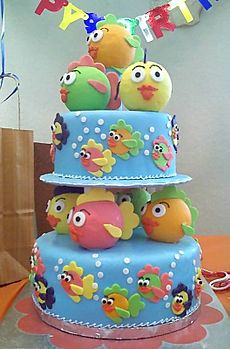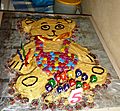Birthday cake facts for kids
A birthday cake is a special cake that people eat to celebrate a birthday. You can find them in many traditions all over the world! Besides classic cakes, there are also birthday cupcakes, cake pops, pastries, and tarts. Birthday cakes often taste like vanilla, chocolate, or strawberry. They come in many shapes and are decorated with colorful icing or fondant.
Contents
History of Birthday Cakes
Birthday cakes have been a part of celebrations in Western Europe since the mid-1800s. But the idea of cakes for birthdays might go back even further, to ancient Roman times.
In ancient Rome, people sometimes served flat, round 'cakes' at special birthdays and weddings. These were made from flour and nuts, helped to rise with yeast, and sweetened with honey.
In the 1400s, bakeries in Germany started making one-layer cakes just for birthdays. Before this, cakes were mostly for weddings. This is how the modern birthday cake began! By the 1600s, birthday cakes looked much more like they do today. These fancy cakes had many layers, icing, and decorations. However, only very rich people could afford them. Thanks to the Industrial Revolution, more materials became available. This made birthday cakes affordable for everyone.
Modern Birthday Traditions
Today, the birthday cake or dessert is served to the person celebrating their birthday. In many Western countries, the birthday person blows out candles on the cake.
There isn't one strict rule for birthday cakes. But in English-speaking countries, people often sing the "Happy Birthday" song while the cake is served. The words "Happy Birthday" didn't appear on cakes until this song became popular in the early 1900s. Other countries have their own birthday songs and traditions. For example, in Uruguay, guests touch the birthday person's shoulder or head after singing. In Ecuador, the birthday person takes a big bite of the cake before it's served to others.
Birthday cakes are often decorated with small candles. These candles are held in special holders or simply pushed into the cake. You might also have other sweets like ice cream with your cake. In places like the UK, North America, and Australia, the number of candles usually matches the person's age. Sometimes, an extra candle is added for good luck! Traditionally, the birthday person makes a wish. People believe the wish will come true if all the candles are blown out in one breath.
To show joy and togetherness, the cake is shared among all the guests at the party.
Candles and Their Origins
No one knows for sure why we blow out candles on birthday cakes. But there are a few ideas about where this tradition came from.
Greek Origin Story
One idea is that the ancient Greeks used candles to honor the goddess Artemis. She was the goddess of the moon and hunting. They would place candles on cakes to celebrate her birth on the sixth day of every lunar month.
Pagan Origin Story
Using fire in special ceremonies is a very old tradition. Birthday candles might have a symbolic meaning. In the past, some people believed that evil spirits visited people on their birthdays. To protect the birthday person, people would gather around them and make them happy and noisy. This noise was meant to scare away any evil spirits.
German Origin Story
In 18th-century Germany, the tradition of candles on cakes can be linked to Kinderfest. This was a special birthday celebration for children. German children would go to a hall-like place to celebrate another year of life. Germans believed that adults protected children from evil spirits trying to harm them. Back then, people didn't usually bring gifts to birthdays. Guests would simply bring good wishes. If a guest did bring a gift, it was seen as a good sign. Later, flowers became a popular birthday gift.
In 1746, a big birthday party was held for Count Ludwig von Zinzendorf. Someone described the party, mentioning a huge cake with holes for candles. There was one candle for each year of the person's age, plus one in the middle. This shows that the tradition was to have one candle for each year of life. Sometimes, there were even extra candles for future years.
Swiss Origin Story
In 1881, a record from Switzerland mentioned the tradition of blowing out candles. Researchers wrote about different "superstitions" among the Swiss middle class. One description talked about a birthday cake with lit candles, one for each year of life. The person celebrating had to blow out each candle, one by one.
Birthday Cakes Around the World
Many different sweets are eaten around the world to celebrate birthdays.
- In China, the traditional birthday pastry is the shòu bāo. This is a bun filled with lotus paste. It's shaped and colored to look like a peach. Instead of one big pastry, each guest gets their own small shòu bāo.
- In Korea, the traditional birthday dish is seaweed soup.
- In Western Russia, children celebrating their birthday get fruit pies. These pies often have a birthday greeting carved into their crusts.
- The Swedish birthday cake is like a pound cake. It's often topped with marzipan and decorated with the national flag.
- Dutch birthday pastries are fruit tarts topped with whipped cream.
- In India, birthday celebrations are becoming more common in cities and towns. People there often use birthday cakes similar to those in Western countries, especially among those with more education.
Images for kids
-
Birthday cake in the shape of a teddy bear
-
Cutting a Calavera shaped birthday cake
-
Birthday cake in the shape of a Lace monitor
-
Tteok-cake
-
Association football themed birthday cake
-
Birthday cake in the shape of a ladybug
See also
 In Spanish: Pastel de cumpleaños para niños
In Spanish: Pastel de cumpleaños para niños





























